The BOSS Katana 50 Guitar Amplifier IS the best guitar-related purchase I’ve ever made. Why? Let me explain.
Is the BOSS Katana 50 loud enough to gig with?
The question that everyone’s asking. Simple answer… ABSOLUTELY!. That’s on the 50W mode, clean channel, gain just less than half, volume the same, and master maxed. In fact, given the volume to spare, you could also opt for the 25W mode, cranking both volumes for a little extra sustain and punch. Band setup was vocals, (loud) drummer and bass. The BOSS Katana 50 wasn’t miced up, and all my gain/fx was provided by the BOSS ME-80 Mult-FX (Ibanez Tubescreamer (TS-clone)). Solo boost was also not a problem with the solo mode of the ME-80 providing a gain and volume hike for solos. The Katana coped unbelievably well with a range of styles.
Legendary versatility?
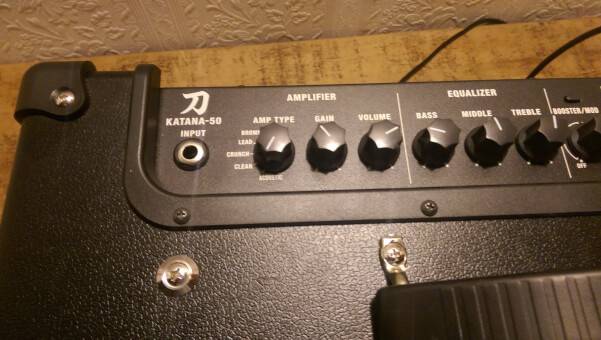
The BOSS Katana 50 has an almost embarrassing array of features. Every BOSS effect you could ever imagine, all the overdrives, distortions, even the newer TERA echo etc, all in the box. Absolutely everything you’ll ever need. But here are the drawbacks of the FX:
- You only get to use 3 of them at once, assigned to just three ‘slots’ BOOST/MOD, Delay/FX and Reverb.
- Further to that, those 3 slots restrict the types of FX you can assign to them, e.g. you can’t apply a MOD effect to the Reverb patch if you’d require an additional MOD.
- Any sort of meaningful tweaking must be done in BOSS TONE STUDIO, and for that, you need to hook up your laptop/PC.
- Some of the FX parameters aren’t writeable, e.g. the Parametric EQ will let you alter the frequency gain, but will auto-assign the level after you save. In other words, you’ll be able to boost your LOW-MIDS level, but you won’t be able to save the tone setting.
Still, with all that and 5 channels (Acoustic, Clean, Crunch, Lead and Brown), you can have a LOT of fun practising at home.
The Katana 50 includes 2 banks of 2 channels, (2 banks of 4 channels on the BOSS Katana 100) plus a ‘panel’ channel (current knob settings). This, of course, allows you to save and recall your favourite tone settings and is handled in the most intuitive way imaginable. Just tweak your settings and when you’re happy, hold down the channel button you wish to assign your tone to.
Gain, Volume, 3 band EQ, Master. All present and correct, although the BOSS Katana 50 lacks the presence control of the 100, I’ve never missed it.
Then there are the power modes. 0.5 W, 25 W and 50 W. All useable. 0.5 W for home, 50 W for ultimate headroom live and 25 W if you wish to beef things up a bit live. Again. Intuitive, well thought out, simple and useful.
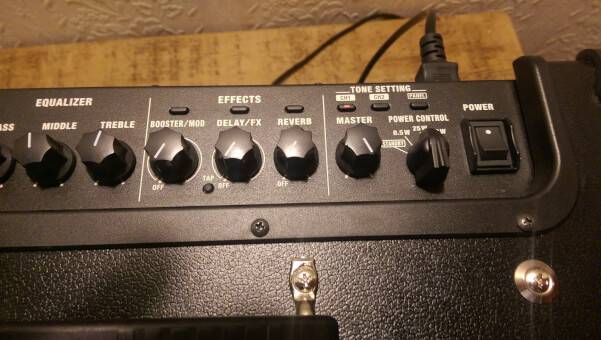
Need an emulated line out to p.a. to augment or boost your live tone? You’ve got it.
You can even change the whole character of your amp’s tone with the detailed Global EQ.
Full specs here
Build quality and looks
First impressions couldn’t be better. It’s clean-looking, modern, business-like, no-nonsense. Nothing is superfluous, it’s tiny and it’s light. The BOSS logo with the Katana Logo looks great, it’s rubbery rather than plastic and doesn’t look cheap at all. Everything is constructed tidily, with not a glitch to be seen. It’s well designed with a reassuringly sturdy handle, corner protectors, chunky knobs inspire confidence, even the screws look solid. All it all it puts my last amp, the Fender Blues Junior III (review here) to shame.
Sadly, once you start to ding it, you realise it’s not covered in a tough tolex, and knocks WILL mark it up due to the softer construction material. It’s looking a little battered already. From a distance, it looks indestructible, but this is an amp you’ll need to protect, cosmetically at least.
The BOSS Katana 50 sits proudly alongside its famous line of compact pedals and multi-FX. Purposeful and gig-ready.
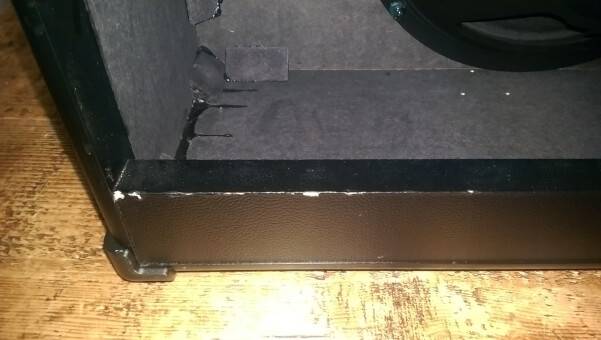
Sounds
So how does the BOSS Katana 50 stack up tonally? Could it really be a viable replacement for your valve amp? Unbelievably, the answer is yes again!
First, let’s not get carried away, as a practice amp, the various channels and FX work great, but for live use, you may need more versatility in the switching which the BOSS (even the Katana 100) doesn’t have. In this scenario, it’s best to run the Katana 50 clean and control everything through external pedals (no FX loop in the Katana 50).
And what a clean channel!
Ok, the BOSS Katana 50 isn’t going to quite get you those crystalline valve-driven Fender highs, but it will get you a perfectly good neutral, full-bodied clean tone as an ideal pedal platform, with headroom to spare. Adding the OD of your choice gets you into whatever ballpark you desire. For me the TS-Clone of my ME-80. Of course, for those willing to experiment, you could always explore BOSS Tone Studio and in particular, those mysterious ‘sneaky’ amps to find that tone (there’s a ‘Twin’ amp I believe), who knows?
In an A/B Test, maybe the BOSS Katana 50 would maybe fall short of my old Cornford (see my review here), but in a gig situation, I honestly didn’t find it lacking in the slightest. The issue I did have with my Blues Junior was headroom, it just didn’t have enough oomph to cope with volume hikes for solos. No such trouble with the Katana 50.
The Katana 50 doesn’t come across as being ‘digital’ or ‘modelled’ at all, it’s just a light, small, loud box organically amplifying your pure guitar signal. The trick is to add whatever flavours you wish. I’d love to hear how the BOSS Katana handles classic stand-alone pedals, (e.g. an original Ibanez Tubescreamer). For now, the BOSS ME-80 more than does the trick.
Going back to the other channels, I can see the acoustic channel being a godsend for the odd acoustic number, but the crunch, lead and brown channels, in my opinion, betray the amp’s digital DNA the most, and would be best reserved for home-use only, they just don’t have the sheer weight of tone that you get from the clean channel + pedals. They are, however, extremely fun to play around with if heavy gain is your thing. I get a distinct impression that BOSS intentionally designed it this way.
One thing’s for sure, the BOSS Katana 50 can cover a LOT of tonal ground, from squeaky clean to layers upon layer of filth, with or without adding in the internal boosts, distortions etc.
Plugging in your PC/Laptop and installing BOSS Tone Studio opens up an almost limitless world of sonic possibilities turning the Katana 50 into the ultimate amp for experimentation at least, and small and light enough to not be a burden for home practice, it’s just going to take a LOT trial and error along the way. A tinkerer’s wet dream.
Also, note that running the BOSS Katana 50 with any onboard overdrive/distortion would mean you wouldn’t be able to run an external delay without getting a horribly messy/distorted tone. That’s just how it is, and guitarists have been finding ways around it for years.
Much has been written about how the BOSS Katana 50 compares to valve amps. The Katana easily wins on value for money, convenience, weight, size and versatility, but what about that unmistakable valve tone? Well, it’s true it’s easier and quicker to arrive at a great sound from a valve amp. they’re more set and forget, plug and play. The Katana took a little more effort…
… First of all, the MID control of my valve amps was more predictable, they boosted the MIDS, provided more bark, as you would expect. The BOSS Katana is different in that increasing the MIDS tends to mush out the tone anything over 12 o’clock. Once I’d backed off the MIDS, I had a superior clean tone, with the bark provided by the external OD. I still got there, it just took a little extra work.
Also, I’ve noticed that cleaning up on the guitar volume is less effective, with the top end disappearing a little earlier than before, however, I put that down to the type of OD I’m using (The TS-Clone), which is known for this. Who knows what it would sound like with an original BOSS Blues Driver for example.
Bottom line, I used to gig with a Cornford Roadhouse 30 at a medium gain to cover most Rock / Indie / Pop applications over the course of a gig. Effects went through the FX loop (including a clean boost). Wah and tuner went through the front. Now I go through a BOSS ME-80 direct to the clean Katana 50. 2 cables, fewer power leads and I’m good to go.
The Cornford just didn’t live up to the hype. It was rather inconsistent, sometimes the cut was there, other times it faded into the background, mushing out into nothing.
On the other hand, the BOSS Katana 50 exceeds expectations, delivering a consistently clean, clear, strident poke that cuts through a band mix extremely well. It’s all there at my fingertips.
The 25 W mode, in particular, is the ace up the Katana 50’s sleeve, and a feature absent on the bigger models. To give you an idea, I gigged the Katana in 50 W mode, which was a nice clean, controlled, balanced tone, but, when pushed I like my amps to sustain into harmonic feedback, and get a little ‘out of control’ when required. The headroom won’t allow for this in 50 W mode, it’s loud but too polite. However, switch it into 25 W mode and those sustained chords began to boom a lot more, lead lines sing, and my semi-acoustic, an Epiphone ES-335 PRO (fantastic guitar) really starts to roar.
I know it’s not a valve power stage at work, but when it sounds this good, who cares?
Tone wise at least, ran clean(ish), the BOSS Katana is a game-changer for solid state/modelling amplification in that for the first time I’ve found a tone that sounds and reacts like a valve amp but without any of the drawbacks of weight, cost, and maintenance. I can’t see why I would ever need to go back to my Conford or my Fender.
Reliability
Two things. The BOSS Katana 50 has no valves to worry about, and it’s built BOSS, a manufacturer renowned for reliability. This gives the Katana an aura of invincibility, even taking into account the flimsy construction. Sure it may fall apart if I’m clumsy and knock it, but I’d put money on it still working afterwards.
After years of anxiety over failed valves, that’s a priceless position for any guitarist to be in. It’s all about confidence, and the BOSS Katana 50 grants you just that.
Having said that, the BOSS Katana 50 is still unproven in the field, only time will tell if it lives up to the reputation.
Value For Money
Taking everything into account, it’s easy to forget the BOSS Katana 50 retails at around £160 GBP. That’s the same as a high-end pedal. We’ve been comparing it unfairly against valve amps that cost exponentially more, yet the Katana still delivers. And unlike valve amps, you’ve got the features, versatility and renowned BOSS reliability. The competition (below) in its price range and quite a bit above are mere toys in comparison. Honestly? Even now it still seems too good a deal to be true, so much so that any guitar player would be a fool to ignore it.
The BOSS Katana 50 is almost in the casual/gift purchase bracket, yet it could be the last guitar amplifier you’ll ever need.
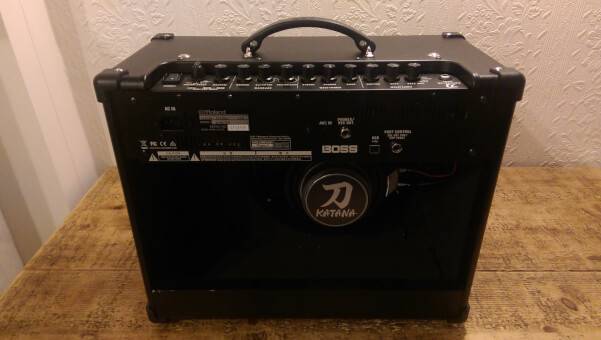
Reservations?
Well, I would have loved an extra FX slot so that I could have utilized a BOOST, MOD and DELAY together, I would also have loved the GAFC footswitch functionality of the Katana 100 to be able to switch individual FX IN and OUT. As it stands, for me at least the Katana 50 (and for that matter the Katana 100), can’t deploy its features intuitively enough in a live environment anyway, which is where the clean channel and external pedals come in.
Second on my wish list would be mobile app control in addition to BOSS Tone Studio. Other manufacturers have done it (See the Marshall Code below) as well as BOSS themselves on the new Katana Air. It could make life a lot easier as no-one wants to lug a laptop/PC around with them to a rehearsal to experiment. Granted you can always build your patches at home, but sometimes you just need to hear the results at volume, in the environment, you’ll be using them in. BOSS seems to be playing catch-up technology wise in this regard, but I’m glad they’ve focussed their efforts (and resources) on building a traditional-sounding guitar amp, first and foremost.
…. Bluetooth connectivity would have also been very useful.
It would’ve been nice to have an FX loop on the Katana 50, just to be able to use the gain channels live. This feels like a deliberate ploy from BOSS (along with GAFC switching) to steer customers to the bigger Katana 100, or maybe it’s to bring the Katana 50 down to its extraordinary price-point?
Please, could we also have a lower powered 0.1 W mode? The 0.5 W is fine but too loud to crank at bedroom levels.
Concerns over the build quality of the cabinet and the live application of the gain channels? I’ll get a cover. For the money, I don’t think anyone could have expected a multi-channel amp with complete control over everything.
The fold-out ‘stand’ is a bit of a gimmick, I quickly lost its tightening screw, so it no longer stays up, once it is up, it doesn’t provide enough angle to be effective anyway. It’s either pointed to your feet, or to your ankles! Solution? another easy one, grab a chair!
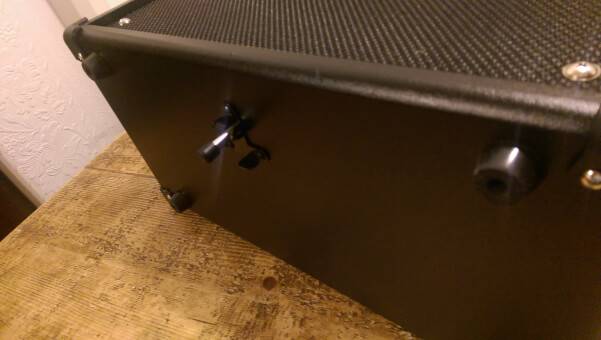
Lastly, getting the BOSS Katana 50 to stand out above a band mix did take a while to set up. In fairness to the amp, it was all about running the amp as cleanly as possible, and as previously mentioned, with the mids dialled back to no more than 12’oclock. It was also about maxing the master on my BOSS ME-50 to get the strongest signal possible into the Katana 50. I put this down to the expansive versatility of the Katana’s tones.
BOSS Katana 50: The Competition
The Katana seems to strike the perfect balance of price, build, features, power and tone. There is competition out there, but always at a compromise. The Marshall is more expensive with reportedly flaky reliability but has app control and better switching. The Blackstar’s less powerful but heavier on features and technology. The Fender loses out on tone but again makes up for it in digital wizardry (It’s also a great looking amp), and the Vox is the most threadbare when it comes to features but packs a classic tonal punch, at an increased price.
Marshall Code Series
Blackstar ID Series
Fender Mustang Series
Vox Valvetronix Series
BOSS Katana 50 vs 100
Another topic of much debate. The Katana series is rapidly expanding (full details here), so if you need a head, MIDI, a 2×12 or a portable amp, you’re catered for. The 50 and the 100 are the hardest to choose between, however, with the 100 featuring a larger speaker magnet and cabinet, resulting in a fuller bass response and a bigger sound. The 100 also has an FX loop, a presence control, 4 channels (to the Katana 50’s 2), and best of all, a GAFC controller input, which allows you to select between patches, banks, and even individual FX slots and the FX loop.
For me personally? The 100 has the same switching limitations as the 50, even with the GAFC controller. For example, I always need a volume gain boost, with whatever other FX I have selected. I could use the BOOST/MOD slot, but that would stop me from using any MOD FX for that slot. There is a workaround on the 100, which is to assign a volume boost to the FX loop. This isn’t ideal as you only get a clean boost and you’ve taken the FX loop out of action for any other FX.
Also, you’re still going to need a tuner, (and for me, a wah), which is a further limitation of the GAFC. Again, you could buy an expression pedal and use the internal Katana Wahs, but again it’s a compromise in that you’ll be taking out another FX slot.
All in all, I plumped for the 50, as I knew I needed an external multi-FX for a tuner + wah, and a way to get around the limitations of the Katana internal FX for live use. It was still loud enough to gig with, and unlike the 100, has the 25 W power mode which is ideal for my gigging needs. The 50 is also cheaper, lighter, smaller and simpler.

Conclusion
BOSS’ design geniuses have absolutely nailed it with the Katana 50. I love this amp and everything about it. Of course, 4 channels + panel won’t be enough for some people (including me) for live use, but that’s the real trick to the Katana. It’s 3 amplifiers in one. The ultimate practice/experimentation amp, utilising all the features of BOSS Tone Studio, a one-stop recording solution, and, to top it off, a tremendously small, light and loud neutral clean pedal platform for live use.
Infinitely more convenient than many valve amps, at a fraction of the cost, the BOSS Katana 50 exudes class and dependability, delivering unbelievably organic (and loud) tones to the point where the whole valves vs solid state/modelling debate doesn’t even matter anymore.
Most of all, the BOSS Katana has allowed me to simplify my setup, gigs have become easier, I’ve less to carry and no longer have any hang-ups over valves or backups, without sacrificing tone…
…The BOSS Katana 50 IS the best guitar-related purchase YOU’LL ever make.
Looking for a BOSS Katana 50?
The Boss Katana 50 has been replaced with the newer v2 model. You can support the blog by ordering through my Guitar Centre affiliate link here, or by clicking the image below.
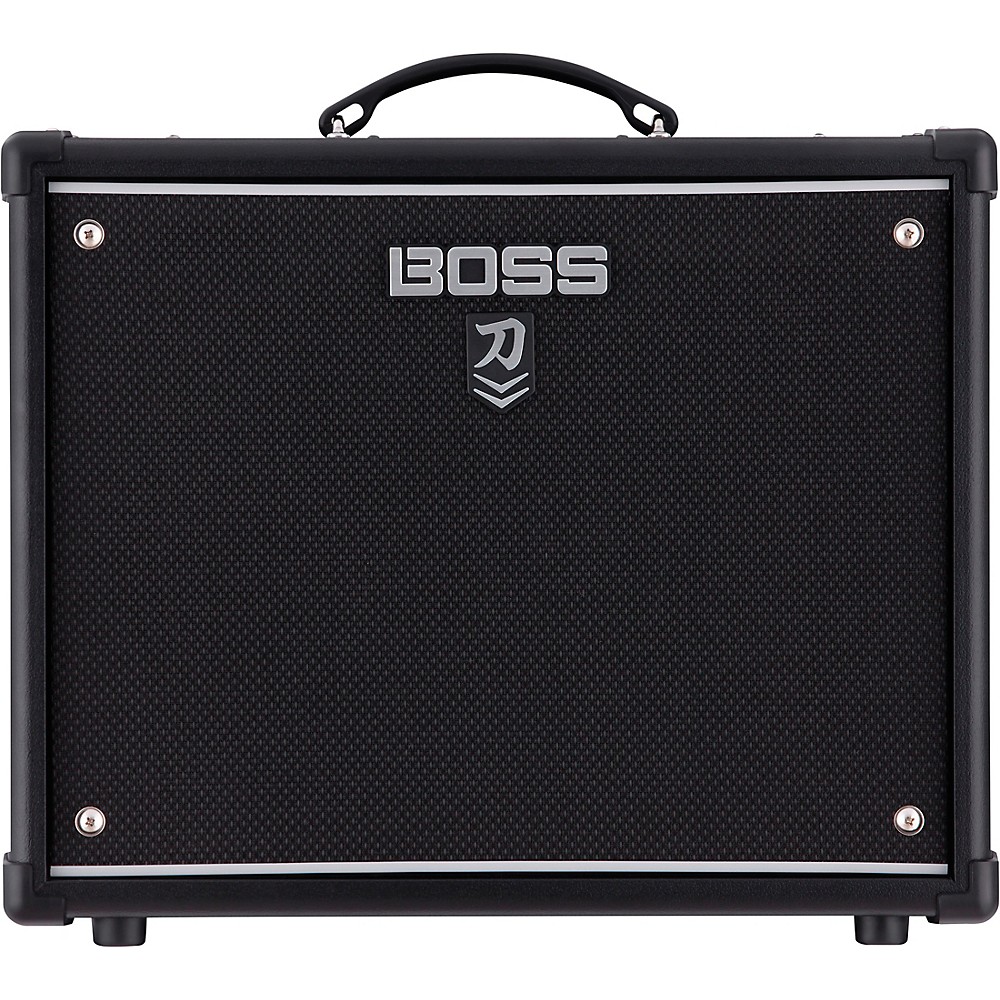
More Guitar Amplifier Reviews @ The Blogging Musician :
Fender Blues Junior III review
Cornford Roadhouse 30 Guitar Combo Amplifier Review
Laney LC30 Mark I Guitar Amplifier Review
Line 6 Spider V, FBV 3 Pro Foot Controller, and Relay G-10 Wireless System Review!
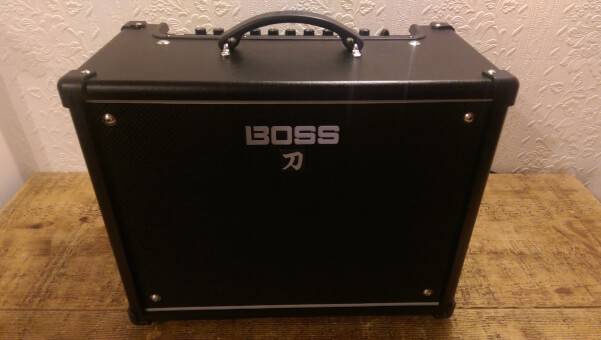
Leave a Reply